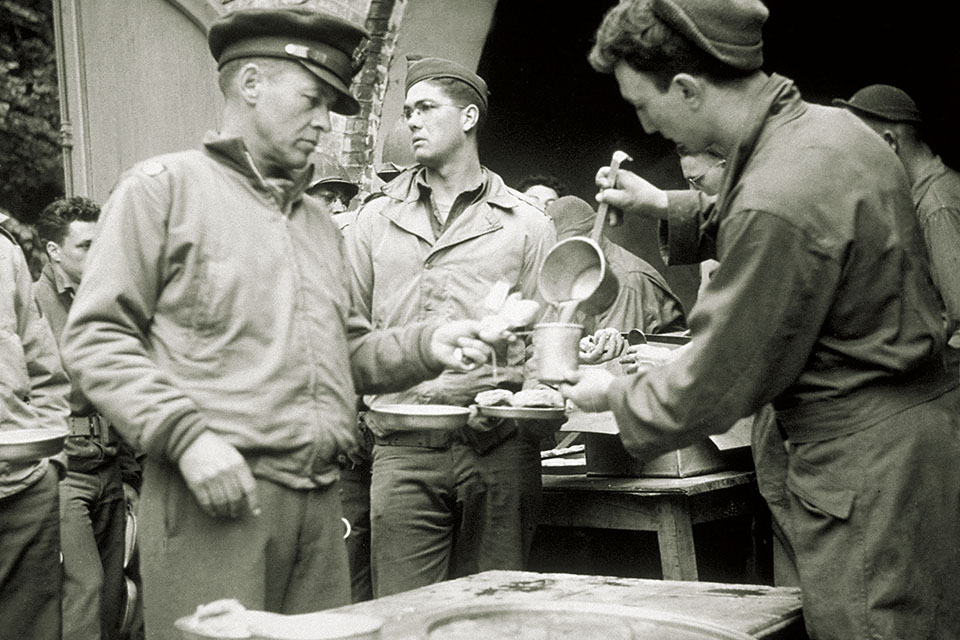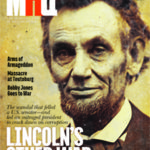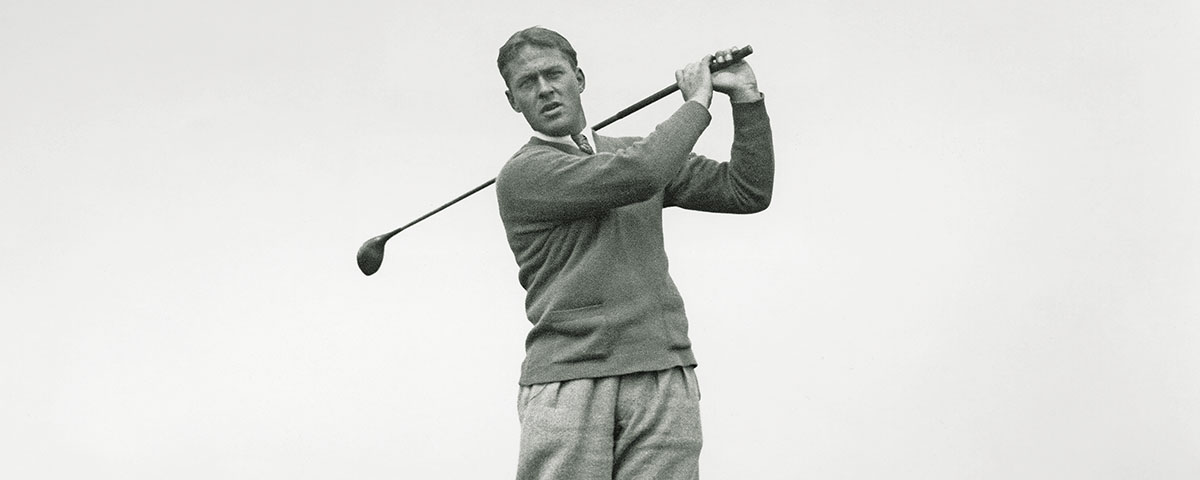ON JUNE 23, 1942, CAPTAIN ROBERT TYRE JONES JR. REPORTED FOR DUTY at Mitchel Field in Long Island, New York, to Brigadier General John K. Cannon, the commander of the Army Air Force’s Interceptor Command, which provided air defense for the northeast coast of the United States. Assigned to the Aircraft Warning Service, Jones spent 10 weeks in Harrisburg, Pennsylvania, studying the strategy of saturation bombing and learning the finer points of aerial-photo interpretation. The service had been formed in the wake of the Japanese attack on Pearl Harbor to watch for enemy planes entering American airspace.
Jones could easily have gotten out of serving in World War II because of his 4-F classification. He was 40 and a married father of two. But like so many others of his generation, he felt a strong sense of duty to take part in the war effort. A member of the Army Reserve for more than a decade, he lobbied the commanding officer of his group to allow him to take up active service, insisting that he didn’t want his role to be merely ceremonial. “I don’t want to be a hoopty-da officer of some camp,” Jones told him.
JONES HAD BEEN TOO YOUNG TO SERVE IN WORLD WAR I—he was just 16 when Germany signed the armistice in 1918. Instead, the young golf prodigy toured the country with three other leading amateur golfers—Perry Adair, Elaine Rosenthal, and Alexa Stirling. Dubbed “the Dixie Kids,” the four young golfers raised nearly $250,000 for the war effort by playing a series of Red Cross exhibition matches.
From his debut in the U.S. Amateur Championship in 1916 until the summer of 1923, Jones endured what would become known as his “seven lean years.” But finally, in 1923, he broke through with a victory at the U.S. Open. Then came the “seven fat years,” in each of which Jones won at least one of golf’s major championships—with the 1923 Open win, a total of eight consecutive championship years.
In 1930 Jones made history by winning golf’s four major championships—the British Amateur, British Open, U.S. Open, and U.S. Amateur—in a single year. Jones’s Grand Slam catapulted him to worldwide stardom, placing him alongside such titans of sport as baseball’s Babe Ruth and boxing’s Jack Dempsey.
Then Jones stunned the world by announcing his retirement from competitive golf. He was only 28.
In 1926 Jones had entered Emory University School of Law and, after only three semesters there, passed the Georgia bar exam. While building his law practice in Atlanta, Jones began pursuing his vision for a high-profile golf club with a layout that he would design in collaboration with British golf course architect Alister MacKenzie. The Augusta National Golf Club opened in 1933, and what began there the following year as an invitational soon blossomed into one of the world’s premier golf tournaments: the Masters.
In the summer of 1936 Jones traveled to Berlin with one of his closest friends, Robert Woodruff, the president of the Coca-Cola Company, to see the games of the eleventh Olympiad. The trip made a lasting impression on Jones, and not just because of Jesse Owens’s historic four gold medals. As he later told his grandson, Bob Jones IV, he sat so close to Adolf Hitler that he could have spit on him.
Japan’s December 1941 attack on Pearl Harbor sent America to war and turned the sports world on its head. The Masters, the first major tournament on the golf calendar, was just four months away, so Jones and his Augusta National cofounder, investment banker Clifford Roberts, had to make a quick decision. They chose to hold the event, but it soon became clear that the 1942 Masters would be the last tournament at Augusta National until the war was over.
Jones had also made an important personal decision. While he could have stayed on the homefront, playing exhibitions to raise money for the war effort, he chose instead to seek an active-duty commission.

“The army wanted him to do what a lot of famous people were doing—to take a more ceremonial role,” his grandson recalls. “He really wanted no part of that. He also didn’t want to be part of the Judge Advocate General’s Corps.”
Before reporting for duty, Jones played one final tournament, the Hale America Open in Chicago, where, much to the delight of spectators, he wore khaki as a signal of his pending move into the military. “I’m very happy over this opportunity to serve,” Jones told reporters after getting his assignment. “I had been looking around to see what I could do and about a month ago sent in my application. I am very glad that it has come through and I am anxious to get going.”
In early 1944 Jones shipped overseas to the 84th Fighter Wing, Ninth Air Force. It was his first visit to Europe since 1936. Even though he was a lot closer to combat action, Jones was pleased to get the assignment. “I was tired of fighting the Battle of the Atlantic Seaboard,” Jones told the Atlanta Journal.
Now a major and a trained intelligence officer, Jones would soon get to play a role in the biggest operation of World War II. Shortly after his arrival in England, he was detailed to Operation Overlord, led by General Dwight D. Eisenhower, the Supreme Allied Commander, and was part of the huge D-Day invasion of the Normandy coast. Jones’s unit was converted to infantry and encountered intense enemy fire for two days following the landing.
Jones then spent two months on the front lines in France, where he was promoted to lieutenant colonel. At one point, even though he spoke very little German, Jones was assigned to interrogate German prisoners of war because, the story goes, he’d mentioned to a colonel that he’d read Goethe. “He thought I meant in German,” Jones said.
About a month after the Allied forces landed at Normandy, Jones had his first face-to-face encounter with Eisenhower when the two men were invited to a dinner at the wartime residence of aviation pioneer Lewis H. Brereton, a lieutenant general in the U.S. Air Force. The dinner was prepared by French chefs and followed by some Courvoisier “liberated” by Brereton’s aides. But for Eisenhower, an avid golfer, the highlight of the evening surely had to be meeting Jones.
Meanwhile, Jones’s beloved golf club, Augusta National, remained closed. When the war began, the club had arranged to build a practice range and putting green at nearby Camp Gordon as a gift from the Masters, and Roberts had decided to raise cattle and turkey on the now unused course. The turkey operation turned a profit, but the cattle business lost about $5,000, and the herd severely damaged the course.
In 1945, 42 German prisoners of war detained at Camp Gordon were assigned to work on the Augusta National course as it prepared to reopen. As part of an engineering unit assigned to Field Marshal Erwin Rommel and his famed Afrika Korps, the men had helped build river bridges for Rommel’s panzers in North Africa. At Augusta National they built a wooden truss bridge over Rae’s Creek near the 13th tee.
IN 1946, TWO YEARS AFTER JONES RETURNED FROM WORLD WAR II, the Masters Tournament resumed. Eisenhower became a member of Augusta National in 1948, four years before he would be elected president of the United States.
Jones played in the Masters that year, as he had always done, and not long after that he played his final round of golf. A mysterious illness had been bothering him, and he was eventually diagnosed with syringomyelia, a rare disorder that over time destroys the spinal cord. While his health steadily declined through the 1950s and 1960s, Jones remained a leader in the game he loved and would use a power cart to get out on the course and take in the action. He died in 1971.
Though Jones was proud of his military service, he was always reticent to discuss his wartime experiences, typically saying, “Can’t talk about those things, you know.” MHQ
JOHN BOYETTE is sports editor of the Augusta Chronicle.
[hr]
This article appears in the Spring 2018 issue (Vol. 30, No. 3) of MHQ—The Quarterly Journal of Military History with the headline: Swing Shift
Want to have the lavishly illustrated, premium-quality print edition of MHQ delivered directly to you four times a year? Subscribe now at special savings!






